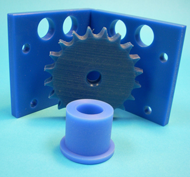 Plastics today are used in almost unlimited number of applications, many of which were previously handled by metal components, especially when the application required the part to be exposed to harsh conditions such as temperature extremes. Today’s modern plastic formulations are superior in many ways to previous generations of plastic materials; however, they come in a wide range of compounds and not all plastics are suitable for all applications. Every plastic formulation has its own unique characteristics, such as durability, tensile and impact strength, temperature range, and more.
Plastics today are used in almost unlimited number of applications, many of which were previously handled by metal components, especially when the application required the part to be exposed to harsh conditions such as temperature extremes. Today’s modern plastic formulations are superior in many ways to previous generations of plastic materials; however, they come in a wide range of compounds and not all plastics are suitable for all applications. Every plastic formulation has its own unique characteristics, such as durability, tensile and impact strength, temperature range, and more.
If you’re selecting a plastic material for a specific application, it’s important to choose it based on the critical properties associated with it, such as thermal expansion – the plastic’s ability to change in shape, area, and volume in response to temperature changes. The coefficient of thermal expansion (CTE) is the degree of expansion divided by the change in temperature. The higher the coefficient number, the more change in size.
There are several major thermoplastic compounds manufactured under various brand names that exhibit good thermal expansion characteristics. Seven of the most common plastic materials for thermal expansion are:
Acetal (POM) offers excellent strength, stiffness, and dimensional stability as well as wear resistance and easy machining. Acetal has a 80-120 coefficient of thermal expansion, and as a polyoxymethylene (POM) homopolymer, a high-end temperature of 248o F while the POM copolymer has a temperature range of -40 to 248o F.
Nylon (PA) is available in a number of formulations with Nylon 101 providing the highest melting point along with great strength and rigidity. It’s well-suited for use in food contact applications such as food processing and packaging conveyor systems. As a polyamide, nylon has a 90-95 coefficient of thermal expansion and a temperature range of -40 to 320 o F.
Polymethylmethacrylate (acrylic) is a highly durable and rigid plastic that also provides good electric insulation and is well-suited for environmental temperature swings. It has a 70-77 coefficient of thermal expansion and a temperature range of -40 to 194 o F.
Polypropylene is of the most popular and common plastic formulations used in a variety of industries and applications; it’s lightweight, tough, and resistant to chemicals. It has a 100-180 coefficient of thermal expansion and a temperature range of -4 to 239o F.
Polyimide is a tough, durable thermoplastic ideal for plastic molding. It’s highly popular for high wear-and-tear components such as hinges, screws, and bearings. It has a 30-60 coefficient of thermal expansion of a temperature range of -454 to 608 o F.
Teflon (PTFE) offers a low coefficient of friction in addition to a high melting point, making it suitable for use in products and systems in which friction and temperature are factors. It has a 100-160 coefficient of thermal expansion and a temperature range of -436 to 500 o F.
UHMW Polyethylene is a thermoplastic polyethylene featuring extremely high molecular density. It’s highly durable, with the highest impact resistance of all thermoplastics and great abrasion and heat resistance. It’s another plastic well-suited for food industry applications. It has a 130-200 coefficient of thermal expansion and a high-end temperature of 203 o F.
If you’re considering thermoplastic components for a conveyor or transport system that is subject to extreme temperatures or temperature changes, the thermoplastic experts at Slideways can help you select the right plastic material for thermal expansion.


